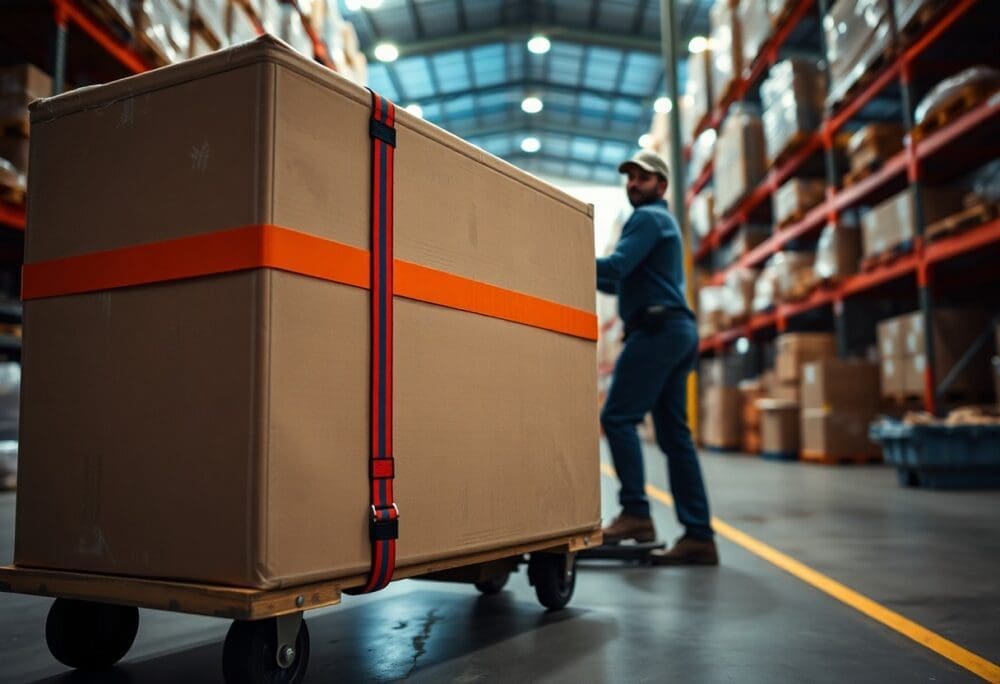Moving heavy items can pose several risks to your safety, but using straps can significantly enhance your ability to maneuver them securely. By distributing weight evenly and reducing the strain on your body, straps allow you to lift, carry, and secure heavy loads more effectively. This guide will explore the various ways straps improve safety during the moving process, ensuring you can handle your heavy items with confidence and minimal risk of injury.
Key Takeaways:
- Straps provide stability and support, distributing weight evenly and reducing the risk of slipping or dropping heavy items.
- Using straps allows for better grip and control, enabling users to maintain a proper posture while lifting, thus minimizing the risk of injury.
- Straps can facilitate team lifting, enabling multiple individuals to work together effectively, which enhances coordination and safety during the movement process.
Understanding the Importance of Safety When Moving Heavy Items
For anyone planning to move heavy items, prioritizing safety is crucial. Failing to adopt safe practices can lead to serious injuries not only for you but also for those around you. Implementing proper techniques and using tools like straps can significantly reduce risks and help you manage the physical demands of moving effectively.
The Risks of Improper Lifting Techniques
Below are some common risks associated with improper lifting techniques. When you lift incorrectly, you expose yourself to a range of injuries, including strains and sprains. Poor posture and sudden movements can place undue stress on your muscles and joints, increasing the likelihood of accidents and long-term damage.
Common Injuries Associated with Heavy Lifting
Common injuries linked to heavy lifting encompass strains, sprains, herniated discs, and even fractures. These injuries can lead to significant downtime and discomfort, impacting not just your ability to move heavy items but also your daily activities.
At times, minor injuries can evolve into chronic pain or permanent damage if left unaddressed. Strains and sprains particularly affect your back, neck, and shoulders, areas that are crucial when lifting. Herniated discs can result from excessive pressure on the spine, leading to severe discomfort and mobility issues. Understanding these potential injuries emphasizes the importance of using safe lifting techniques and protective measures, such as straps, to mitigate risks effectively.
Types of Straps Available for Moving Heavy Items
Assuming you are preparing for a heavy item move, knowing the types of straps available can enhance your safety and efficiency. Here are some common strap types:
| Ratchet Straps | Highly adjustable, ideal for securing large objects. |
| Lifting Slings | Great for lifting heavy items vertically with ease. |
| Moving Straps | Used by movers to redistribute weight and reduce strain. |
| Cam Buckle Straps | Easy to use and perfect for quick setups. |
| Webbing Straps | Versatile and lightweight, suitable for various applications. |
The types of straps you choose will depend on the specific needs of your moving situation.
Ratchet Straps
At the forefront of secure moving solutions, ratchet straps offer enhanced tightening capabilities. You simply place the strap around the heavy item, feed it through the ratchet mechanism, and pull to create a tight grip. This feature prevents the item from shifting during transport, ensuring your items arrive safely at their destination.
Lifting Slings
Between various moving tools, lifting slings stand out for vertical lifting tasks. These straps are designed to provide the necessary strength and support to lift heavy objects without risk of injury to yourself or damage to the items. They often incorporate a loop design, making it easier for you to attach securely to cranes or hoists.
It’s vital to choose the appropriate lifting sling for your needs, as different materials and designs offer varying weight capacities. You can select from nylon, polyester, or other materials based on the load you are handling. By utilizing lifting slings, you can significantly reduce the physical strain typically associated with heavy lifting, leading to a safer and more efficient moving process.
How Straps Work to Enhance Safety
All safety measures in moving heavy items hinge on the effectiveness of straps. By providing a secure hold, straps work to minimize the risks associated with lifting and transporting bulky objects. They ensure that weight is evenly distributed and prevent items from shifting during transit, allowing you to focus on the task at hand with greater peace of mind.
Weight Distribution
Any moving scenario can become hazardous if weight is not properly managed. Straps help you to evenly distribute the load of heavy items, which in turn reduces the strain on your muscles and minimizes the chance of accidents. Proper weight distribution not only makes lifting easier but also enhances overall safety while maneuvering the item.
Stability and Control
Below are the key benefits of using straps for stability and control in moving tasks. Straps anchor heavy items, significantly limiting their movement during transport. As a result, you exercise more control over the load, reducing the risk of injury or damage to the surrounding environment. Safety is enhanced when you have a firm grip on the item and can direct it as needed without the constant worry of losing balance.
With straps, achieving stability and control while moving heavy items becomes much easier. They create a reliable binding that holds an item in place, allowing you to focus on your footing and navigation instead of worrying about the load shifting unexpectedly. By incorporating straps, you can enhance your ability to maintain control over the item, reducing the likelihood of accidents or injuries caused by slips and falls.
Techniques for Using Straps Effectively
Despite the advantages straps offer, using them effectively requires proper techniques. Familiarizing yourself with techniques can significantly enhance your safety and efficiency. You can learn How to Use Moving Straps online, which will guide you through various methods that help ensure a secure grip on heavy items while reducing strain on your body.
Proper Securing Methods
Any improper securing method can lead to accidents or injury when moving heavy items. Ensure you position the strap under the item correctly and loop it securely around your body or shoulder, which will help distribute the weight evenly. Adjust the tightness of the strap to prevent slipping, and assess the item’s balance before lifting to maintain control.
Team Lifting with Straps
Straps enable seamless team lifting by allowing you and your partner to share the weight of heavy items effectively. This coordination not only improves balance but also lessens the physical strain on all involved. By communicating clearly and positioning yourselves correctly, you can synchronize your lift, ensuring that everyone contributes equally to moving the load safely.
And when team lifting with straps, always establish a clear lifting plan. Prioritize alignment and timing to minimize the risk of accidents. You should also practice lifting without the strap to gauge how well your team members can handle the weight, so everyone feels comfortable and secure when the moment to lift arrives.
Additional Safety Equipment to Consider
Not only do straps play a significant role in enhancing safety during heavy lifting, but incorporating additional safety equipment can further minimize risks. Consider utilizing back support belts, gloves, and appropriate footwear to ensure a more secure and comfortable moving experience. Each of these tools provides unique benefits that complement the use of straps, allowing you to focus on moving heavy items efficiently and safely.
Back Support Belts
About back support belts, they help stabilize your core and lower back while lifting, reducing the risk of injury. Wearing one can provide vital support and balance, enabling you to lift heavy items more effectively without overstraining your muscles.
Gloves and Footwear
About gloves and footwear, they are vital for ensuring grip and protecting your hands and feet during heavy lifting. Proper gloves enhance your grip on the items and protect your hands from sharp edges, while suitable footwear provides stability and support, reducing the risk of slipping or falling.
This combination of gloves and footwear is vital for enabling you to handle heavy items with confidence. Gloves should fit well, offering both dexterity and toughness, while anti-slip footwear will keep you steady on various surfaces. By prioritizing these safety measures, you can significantly reduce the likelihood of injury and ensure a more productive moving experience.
Tips for Choosing the Right Straps for Your Needs
Keep these considerations in mind when selecting straps for moving heavy items:
- Assess the weight and dimensions of the items.
- Choose straps with an adequate load capacity.
- Look for materials that ensure durability and grip.
- Consider the strap length for optimal reach.
- Check for added features like adjustable buckles.
This approach will help you find the right straps that enhance your safety and efficiency when moving heavy items.
Load Capacity
Before purchasing straps, evaluate the load capacity required for your specific tasks. Ensure that the straps you select can handle the weight of the items you plan to move. Overloading straps can lead to accidents or equipment failure, so it’s best to err on the side of caution by choosing straps that can manage more than the estimated weight of your load.
Material Durability
Straps should be made from high-quality materials to ensure durability and longevity. When identifying straps, examine the fabric type, stitching quality, and overall construction. Look for heavy-duty materials such as polyester or nylon that resist wear and tear during use. Consider also how well the straps can withstand environmental conditions, such as moisture or UV exposure, to maximize their lifespan.
It’s important to choose straps that are designed to endure repetitive stress and heavy usage. High-quality straps not only enhance safety but also contribute to the efficiency of your moving tasks. Investing in well-made straps means fewer replacements over time and a more reliable aid during your moving activities.
Final Words
Conclusively, utilizing straps for moving heavy items significantly enhances your safety and reduces the risk of injury. By distributing the weight evenly and allowing for a secure grip, these straps help you maintain better control while navigating potentially hazardous environments. Additionally, they provide the necessary support to prevent items from shifting unexpectedly, keeping both you and your belongings secure. Investing in high-quality straps is not just about convenience; it’s a practical step towards ensuring a safer moving experience for you.
FAQ
Q: How do straps help prevent injuries when lifting heavy items?
A: Straps are designed to distribute weight more evenly across your body, reducing strain on your back and limbs. By using straps to secure heavy items, you can maintain better control and reduce the risk of sudden movements that might lead to injury. They allow you to lift with your legs rather than your back, which is a safer lifting technique.
Q: What types of straps are best for moving heavy objects?
A: There are several types of straps ideal for moving heavy objects, including ratchet straps, cam buckle straps, and lifting straps. Ratchet straps are excellent for securing items on a moving truck, while lifting straps can be used to provide extra grip and leverage when carrying bulky items. Each type serves a specific purpose, so it’s important to choose the one that fits your needs for the particular heavy item you are moving.
Q: Can straps be used alone for lifting heavy items, or should they be combined with other tools?
A: While straps can significantly enhance safety during the lifting process, they are most effective when combined with other tools and techniques. It is advisable to use straps in conjunction with dollies, hand trucks, or lifts to provide additional support and stability. This combination allows for easier maneuvering and further reduces the risk of mishaps during the moving process.





